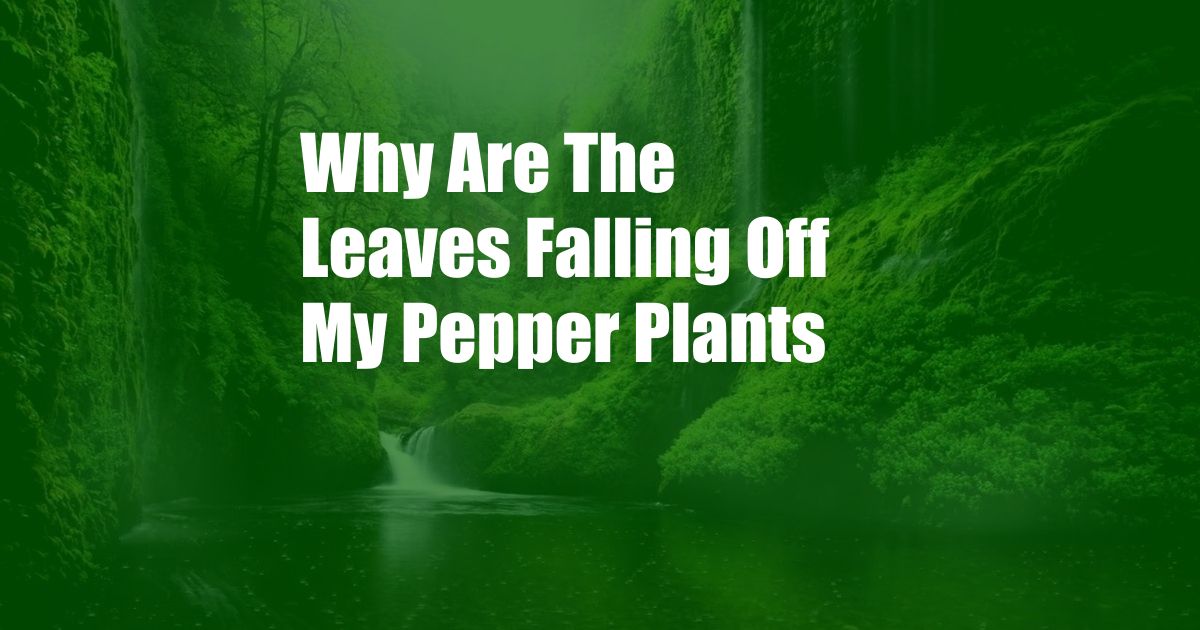
Why Are the Leaves Falling Off My Pepper Plants?
I remember fondly the day I planted my first batch of pepper seedlings. I had high hopes of harvesting an abundance of colorful peppers, but much to my dismay, the leaves started falling off prematurely. I was determined to find out why and prevent this from happening again. After extensive research and consultations with gardening experts, I learned a great deal about the causes of leaf drop in pepper plants and how to address them.
Before we delve into the specific reasons behind leaf drop in pepper plants, it’s crucial to understand that this phenomenon is a natural part of their life cycle as they shed old leaves to make way for new growth. However, excessive or untimely leaf drop can indicate underlying issues that require attention.
Environmental Factors Contributing to Leaf Drop
Water Stress
Pepper plants are sensitive to both overwatering and underwatering. When water levels are insufficient, the plant cannot absorb the necessary nutrients and moisture it needs to sustain its leaves, leading to wilting and eventual leaf drop. On the other hand, excessive watering can suffocate the roots, preventing them from absorbing water and nutrients effectively, resulting in root rot and subsequent leaf drop.
To avoid water stress, it’s essential to water your pepper plants regularly, especially during hot and dry periods. Allow the top few inches of soil to dry out between waterings and avoid overwatering, particularly in heavy or poorly drained soils.
Nutrient Deficiencies
Like all plants, pepper plants require a balanced supply of nutrients, including nitrogen, phosphorus, potassium, and magnesium. Deficiencies in any of these essential elements can lead to yellowing of leaves, stunted growth, and eventually leaf drop. For instance, nitrogen deficiency causes leaves to turn yellow and drop prematurely, while potassium deficiency can lead to browning and curling of leaf edges, followed by leaf drop.
To address nutrient deficiencies, fertilize your pepper plants regularly with a balanced fertilizer. Organic fertilizers, such as compost or manure, can provide a slow-release source of nutrients that benefit the plants over time.
Temperatures and Light
Extreme temperatures and inadequate light can also trigger leaf drop in pepper plants. These plants thrive in warm, sunny environments, but when temperatures drop below 50°F (10°C) or rise above 90°F (32°C), the plant may go into shock and shed its leaves to conserve energy. Similarly, insufficient sunlight can prevent the plant from producing enough energy for growth, leading to leaf loss.
Ensure your pepper plants receive at least 6 hours of sunlight daily and provide protection from extreme temperatures by growing them in a greenhouse or sheltered area during cold or hot spells.
Diseases and Pests
Fungal diseases and pests can also cause leaf drop in pepper plants. Diseases such as bacterial wilt and anthracnose can lead to wilting, yellowing, and premature leaf drop. Pests like aphids and spider mites feed on the leaves, weakening them and causing them to drop off.
To prevent and control diseases and pests, practice good garden hygiene and regularly inspect your plants for signs of infection. Remove infected leaves immediately and use organic or chemical treatments as needed.
Tips for Preventing Leaf Drop in Pepper Plants
- Water regularly: Maintain consistent soil moisture without overwatering.
- Fertilize adequately: Provide a balanced supply of nutrients with regular fertilization.
- Control temperature and light: Ensure plants receive adequate sunlight and protection from temperature extremes.
- Practice good garden hygiene: Remove infected leaves and debris to minimize disease and pest problems.
- Use mulching: Mulch around the plants to retain moisture, suppress weeds, and regulate soil temperature.
- Avoid overfertilizing: Excess fertilizer can burn roots and lead to leaf loss.
- Check for pests: Regularly inspect plants for aphids, spider mites, or other pests and treat them promptly.
Frequently Asked Questions
Q: Is leaf drop in pepper plants always a cause for concern?
A: Not necessarily. Some leaf drop is natural, especially as the plant matures and sheds older leaves. However, excessive or premature leaf loss requires investigation.
Q: Can I prevent leaf drop completely?
A: While it’s not possible to eliminate leaf drop entirely, following good cultural practices and addressing potential issues can minimize its occurrence and maintain healthy plant growth.
Q: Are there specific varieties of pepper plants that are more prone to leaf drop?
A: Some varieties may be more susceptible to certain diseases or pests, which can lead to increased leaf drop. However, all pepper plant varieties can experience leaf loss under unfavorable conditions.
Conclusion
Understanding the reasons behind leaf drop in pepper plants is crucial for effective prevention and management. By providing optimal growing conditions, including proper watering, fertilization, temperature control, and pest control, you can minimize leaf loss and enjoy a healthy and productive pepper harvest. Remember, even experienced gardeners encounter challenges, but with patience and a keen eye for detail, you can overcome these obstacles and grow thriving pepper plants.